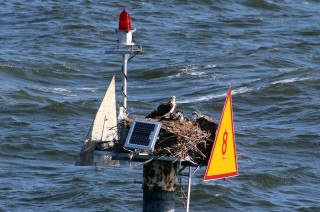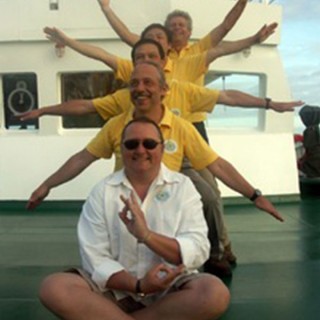![Time to raise the gangplank and cast off lines from shore. [That’s Andy Bowen in the green shirt making sure he has booked his flights to Jamaica!]](http://schmidtocean.org/wp-content/uploads/falkor-port-starboard-320x234.jpg)
No, wait – the other one: Release then Catch!!!
Today was the day that we finally set sail. Up early for a start-the-day meeting with the Captain, Leighton et al. at 7am on the Bridge then time for due diligence: walking around the labs and making sure that all the science party (myself included!) had lashed down all the equipment we have been unpacking since Sunday so that it won’t go flying all over the place as soon as we hit open water. How sad is it that some of my cherished possessions when I go to sea are a collection of non-stick mats, screw in eye-bolts and bungee cords that I can use to make sure my laptop and hard drives full of past expedition data sit snugly, strapped to their bench?

At 9am it was time to raise the drawbridge (sorry, gangplank), cast off the last line and head out away from shore. Last person off the ship was Eric King, Director of Marine Operations from the Schmidt Ocean Institute who had flown in to make sure all was well (I promised him I would try not to break anything) and last person standing to wave us off on the Quayside was Andy Bowen, Director of the National Deep Submergence Facility who had been in port all week (on his way home from Taiwan!) helping us get Nereus ready to go to sea. We’ll see Andy again on Leg 2.
Heading out of port we got a sudden Nature bonus. Where I live on Cape Cod, I get to drive past an Osprey nest on the way to work everyday, and am quite used to seeing them wheeling overhead throughout the Summer months. It isn’t often , though, that I get to look down on a nest with chicks in. But that is what happened today, just a few minutes out of port, rounding a navigation beacon close to the point where the local Coast Guard station is set. An auspicious start to any voyage ☺
This afternoon, soon as we got into open water, our Captain, Heiko, suggested that we break off our transit and take some time to practice both a launch and recovery of Nereus while weather is good and conditions are calm, just so we are all familiar with how to get the interactions working between this new combination of ship and vehicle and Falkor and Nereus personnel. As was to be predicted, letting Nereus go was relatively easy. Getting it back again? Not so much. What is required is a delicate piece of choreography that even Beyonce might be proud of.
First comes the stand off. The Captain sets the ship up so that Nereus is ahead of us, bobbing around in the water and drifting in the current while we do pretty much the same. We look at Nereus, Nereus feigns indifference.
Then, slowly and cautiously, the Captain coaxes the ship ahead such that, as if by magic, the vehicle slides quietly past, close to the hull of the ship, down its starboard side. While this is happening, Mike from the Nereusteam is using a remote control system – something like most people might be more familiar with from a radio-controlled toy car or boat – to drive Nereus’ propellers and line it up so that it is facing in to the side of the ship.
Then, at a critical point that takes extremely delicate judgement on all parts, comes the point where Nereus, sliding sideways past the length of the ship, finds itself looking into the cold hunter’s eyes of our fearless Expedition Leader, Casey, equipped with a long carbon fiber pole (strong but light) with a hook and recovery line attached. As the Captain controls the ship, Mike drives Nereus in right up to the edge of the ship at the point where Casey is standing and Casey reaches down and hooks the line onto Nereus. The hook slides off the end of the pole and with the line now attached (with the other end of that rope secured to a winch at the back of the ship) we let Nereus continue to float past, until it is behind the back of the ship.
What happens next is hard to observe directly (for very good safety reasons, tourist-scientists like me aren’t welcome getting in the way of where all the tricky stuff is going on). But happily we have CCTV cameras all over the ship so we can appreciate the final set of “dance moves”. As Nereus falls astern of the ship, the line that Casey attached is winched in to bring Nereus up close beneath the back of the ship underneath the A-frame and inverted cradle (technical term: swing arrester) it was first launched out of. From there, a lift-line is attached to the top of Nereus and that is drawn in to suck Nereus up snugly into that inverted cradle so that then when the A-frame rotates in-board, the vehicle is returned safely straight into its cradle.
I won’t pretend we got everything right first time this afternoon but that just goes to show why it was such a good idea to take the time to have this practice anyway. We have good ideas now on what won’t work and what our best approach is and by the end of the afternoon, when we settled on that, everything went very smoothly. Nereus was back on deck safely by 5pm and then, after dinner, it was time to call a quick science meeting to make sure everyone knew what the broadest goals for the cruise were, what my highest priorities are for Leg 1, and also what was coming up in the next 24-72 hours so everyone can plan ahead accordingly.
Tomorrow at 7am we have our first CTD cast which will give our scientists some samples from a deep water station off the coast of Florida. The Nereus engineers already have plenty of engineering and science sensor data to look at and will now be working on developing the first dive mission in a few days’ time. But tomorrow is when everybody else gets a first chance to test out the remainder of our systems.
And then it will be full speed round Cuba to get to the Mid Cayman Rise.

